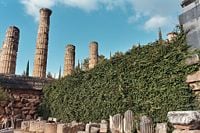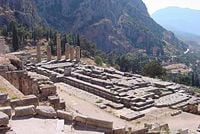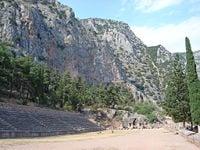Delphi
| Archaeological Site of Delphi* | |
|---|---|
| UNESCO World Heritage Site | |
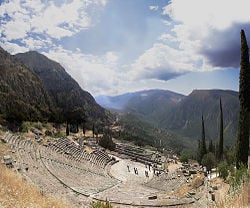
| |
| Type | Cultural |
| Criteria | i, ii, iii, iv, vi |
| Reference | 393 |
| Region** | Europe and North America |
| Inscription history | |
| Inscription | 1987 (11th Session) |
| * Name as inscribed on World Heritage List. ** Region as classified by UNESCO. | |
Delphi (Greek Δελφοί) was one of the most important religious sites in ancient Greece, renowned for its Delphic oracle (the most famous oracle in the classical Greek world). Delphi was also a sacred Panhellenic sanctuary that included a temple to the god Apollo, where every four years athletes from all over the Greek world competed in the Pythian Games. Additionally, Delphi was revered throughout the Greek world as the site of the omphalos stone, the center of the earth and the universe. In the inner hestia ("hearth") of the Temple of Apollo, an eternal flame burned. After the Battle of Plataea (479 B.C.E.), the Greek cities extinguished their fires and brought new fire from the hearth of Greece, at Delphi; in the foundation stories of several Greek colonies, the founding colonists were first dedicated at Delphi.[1]
Today, Delphi is both an archaeological site and a modern town in Greece.
Location
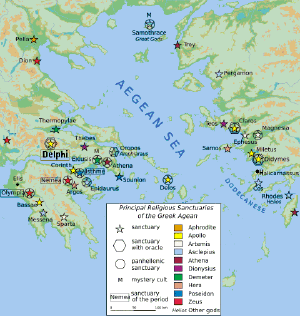
Delphi is located in lower central Greece, on multiple terraces along the slope of Mount Parnassus. This semicircular spur is known as Phaedriades, and overlooks the Pleistos Valley. Southwest of Delphi, about 15 km (9.5 mi) away, is the harbor-city of Kirrha on the Corinthian Gulf.
Dedication to Apollo
The name Delphoi starts with the same four letters (δελφ) as delphus ("womb"), which may allude to veneration of Gaia, the Earth Goddess, at the site. Indeed, H.W. Parke writes, "Delphi was originally devoted to the worship of the Earth goddess whom the Greeks called Ge, or Gaia (mythology)."[2] Apollo is connected with the site by his epithet Δελφίνιος Delphinios, "the Delphinian." The epithet is tied to dolphins (Greek δελφίς,-ῖνος) in the Homeric Hymn to Apollo (line 400), recounting the legend of how Apollo first came to Delphi in the shape of a dolphin, carrying Cretan priests on his back. The Homeric name of the oracle is Pytho (Πυθώ).[3]
Another legend held that Apollo walked to Delphi from the north and stopped at Tempe, a city in Thessaly, to pick laurel, a plant sacred to him (generally known in English as the bay tree). In commemoration of this legend, the winners at the Pythian Games received a wreath of laurel (bay leaves) picked in Tempe.
Delphi became the site of a major temple to Phoebus Apollo, as well as the Pythian Games and the famous prehistoric oracle. Even in Roman times, hundreds of votive statues remained, described by Pliny the Younger and seen by Pausanias. Supposedly carved into the temple were three phrases: γνῶθι σεαυτόν (gnothi seauton = "know thyself") and μηδὲν ἄγαν (meden agan = "nothing in excess"), as well as a large letter E.[4] Among other things, epsilon signifies the number 5. Plutarch's essay on the meaning of the "E at Delphi" is the only literary source for the inscription.
According to myth, the young Apollo killed the serpent Python, named Pythia, because Python had attempted to rape Leto while she was pregnant with Apollo and Artemis. The bodies of the pair were draped around his Rod, which, with the wings created the caduceus symbolic of the god. Since Apollo killed Python, he had to be punished for it, since she was a child of Gaia. As punishment for this murder, Apollo was sent to serve in menial tasks for eight years. A festival, the Septeria, was performed annually portraying the slaying of the serpent, the flight, the atonement, and the return of the God. The Pythian Games took place every four years to commemorate his victory.
Erwin Rohde wrote that the Python was an earth spirit, who was conquered by Apollo, and buried under the Omphalos, and that it is a case of one deity setting up a temple on the grave of another.[5] Another view holds that Apollo was a fairly recent addition to the Greek pantheon coming originally from Lydia. The Etruscans coming from northern Anatolia also worshiped Apollo, and it may be that he was originally identical with Mesopotamian Aplu, an Akkadian title meaning "son," originally given to the plague God Nergal, son of Enlil. Apollo Smintheus (Greek Απόλλων Σμινθεύς), the mouse killer[6] eliminates mice, a primary cause of disease; hence, he promotes preventive medicine.
Oracle
Delphi is perhaps best-known for the oracle at the sanctuary that became dedicated to Apollo during the classical period. The priestess of the oracle at Delphi was known as the Pythia. Apollo spoke through his oracle, who had to be an older woman of blameless life chosen from among the peasants of the area. The sibyl or prophetess took the name Pythia and sat on a tripod seat over an opening in the earth. According to legend, when Apollo slew Python, its body fell into this fissure and fumes arose from its decomposing body. Intoxicated by the vapors, the sibyl would fall into a trance, allowing Apollo to possess her spirit. In this state, she prophesied. She spoke in riddles, which were interpreted by the priests of the temple, and people consulted her on everything from important matters of public policy to personal affairs.
The Oracle exerted considerable influence throughout the Greek world, and she was consulted before all major undertakings: Wars, the founding of colonies, and so forth. She also was respected by the semi-Hellenic countries around the Greek world, such as Lydia, Caria, and even Egypt. The Oracle benefited by the Macedonian Kings. Later, it was placed under the protection of the Aetolians. After a brief period, the Romans started to emerge, who even protected it from a dangerous barbarian invasion in 109 B.C.E. and 105 B.C.E. A major reorganization was initiated, which was interrupted by the wars of Mithridatic Wars and Sulla, who took many rich offerings from the Oracle. Barbarian invasions were the direct cause of harm, burning the Temple, which was damaged severely by the earthquake in 83 B.C.E. Ever since, the Oracle fell in decay and the whole area in great poverty. The small population led to difficulties in finding the right people to fill the posts required. Its credibility waned due to doubtful predictions. When Nero came to Greece in 66 C.E., he took away over 500 of the best statues from Delphi to Rome. Subsequent Roman emperors from the Flavian dynasty contributed significantly towards its restoration. Hadrian offered complete autonomy. Also, Plutarch was a significant factor by his presence as a chief priest. However, barbarian raids during the reign of Marcus Aurelius and removal of statues and other riches (practically looting) by Constantine the Great caused it to decay. The short reign of Julian the Apostate was not capable to improve its situation. Despite this, the Oracle existed until it was ordered to close by emperor Theodosius I in 395 C.E. The site was abandoned for almost 100 years, until Christians started to settle permanently in the area and established a small town about 600 C.E. by the name Kastri.
The "Delphic Sibyl"
The Delphic Sibyl was a legendary prophetic figure who was said to have given prophecies at Delphi shortly after the Trojan War. The prophecies attributed to her circulated in written collections of prophetic sayings, along with the oracles of figures such as Bakis. The Sibyl had no connection to the oracle of Apollo, and should not be confused with the Pythia.
Buildings and structures
Occupation of the site at Delphi can be traced back to the Neolithic period with extensive occupation and use beginning in the Mycenaean period (1600-1100 B.C.E.).
Temple of Apollo
The ruins of the Temple of Apollo visible today date from the fourth century B.C.E., are of a peripteral Doric building. It was erected on the remains of an earlier temple, dated to the sixth century B.C.E., which itself was erected on the site of a seventh century B.C.E. construction attributed to the architects Trophonios and Agamedes.[7]
The sixth century B.C.E. temple was named the "Temple of Alcmeonidae" in tribute to the Athenian family which funded its construction. It was a Doric hexastyle temple of 6 by 15 columns. The temple was destroyed in 373 B.C.E., by an earthquake with the third temple completed on the site by 330 B.C.E. The third temple is attributed to Corinthian architects Spintharos, Xenodoros, and Agathon.[8]
The pediment sculptures are attributed to Praxias and Androsthenes of Athens. Of a similar proportion to the second temple, it retained the 6 by 15 column pattern around the stylobate.[9] Inside was the adyton (sacred sanctuary), the center of the Delphic oracle and seat of Pythia. The monument was partly restored during 1938-1941.
Treasuries

From the entrance of the site, continuing up the slope almost to the temple itself, are a large number of votive statues, and numerous treasuries. These were built by the various states—those overseas as well as those on the mainland—to commemorate victories and to thank the oracle for her advice, which was so important to those victories. The most impressive is the now-restored Athenian Treasury, built to commemorate the Athenians' victory at the Battle of Salamis. According to Pausanias, the Athenians had previously been given the advice by the oracle to put their faith in their "wooden walls"—taking this advice to mean their navy, they won a famous battle at Salamis. Another impressive treasury that exists on the site was dedicated by the city of Siphnos, whose citizens had amassed great wealth from their silver and gold mines and so they dedicated the Siphnian Treasury. The most extensive and well preserved treasury at Delphi was the treasury of Argos. Built in the late Doric period, the Argives took great pride in establishing their place amongst the other city states. Completed in the year 380 B.C.E., the treasury draws inspiration mostly from the Temple of Hera located in the Argolis, the acropolis of the city. However, recent analysis of the Archaic elements of the treasury suggest that its founding preceded this.
As a result of these treasuries, through the protection of the Amphictyonic League, Delphi came to function as the de-facto Central Bank of Ancient Greece. It was the abuse of these treasuries by Philip of Macedon and the later sacking of the Treasuries, first by the Celts, and later by Sulla, the Roman Dictator, that led to the eclipse of Greek civilization and the eventual growth of Rome.
Altar of the Chians
Located in front of the Temple of Apollo, the main altar of the sanctuary was paid for and built by the people of Chios. It is dated to the fifth century B.C.E. by the inscription on its cornice. Made entirely of black marble, except for the base and cornice, the altar would have made a striking impression. It was restored in 1920.[10]
Stoa of the Athenians
The stoa leads off north-east from the main sanctuary. It was built in the Ionic order and consists of seven fluted columns, unusually carved from single pieces of stone (most columns were constructed from a series of discs joined together). The inscription on the stylobate indicates that it was built by the Athenians after their naval victory over the Persians in 478 B.C.E., to house their war trophies.
Polygonal wall
The retaining wall was built to support the terrace housing the construction of the second temple of Apollo in 548 B.C.E. Its name is taken from the polygonal masonry of which it is constructed.
Gymnasium
The gymnasium was a series of buildings used by the youth of Delphi. The building consisted of two levels: a stoa on the upper level providing open space, and a palaestra, pool and baths on lower floor. These pools and baths were told to have magical powers, and the ability to communicate to Apollo himself.
Castalian spring
The sacred spring of Delphi lies in the ravine of the Phaedriades. The preserved remains of two monumental fountains that received the water from the spring date to the Archaic period and the Roman, with the later cut into the rock.
Stadium
The stadium is located further up the hill, beyond the via sacra and the theater. It was originally built in the fifth century B.C.E. but was altered in later centuries. The last major remodeling took place in the second century C.E. under the patronage of Herodus Atticus when the stone seating was built and arched entrance. It could seat 6500 spectators and the track was 177 meters long and 25.5 meters wide.[11]
Theater
The ancient theater at Delphi was built further up the hill from the Temple of Apollo giving spectators a view of the entire sanctuary and the valley below. It was originally built in the fourth century B.C.E. but was remodeled on several occasions since. Its 35 rows can seat 5,000 spectators.[12]
Tholos
The Tholos at the sanctuary of Athena Pronaia is a circular building that was constructed between 380 and 360 B.C.E. It consisted of twenty Doric columns arranged with an exterior diameter of 14.76 meters, with 10 Corinthian columns in the interior.
The Tholos is located approximately a half-mile (800 m) from the main ruins at Delphi. Three of the Doric columns have been restored, making it the most popular site at Delphi for tourists to take photographs.
Vitruvius (vii, introduction) notes Theodorus the Phocian as the architect of the Round Building located at Delphi.
Excavations
The site had been occupied by the village of Kastri since medieval times and this had to be relocated before a systematic excavation of the site could be undertaken, a relocation resisted by the residents. The opportunity to relocate the village was presented when it was substantially damaged by an earthquake, with villagers offered a completely new village in exchange for the old site. In 1893, the French Archaeological School removed vast quantities of soil from numerous landslides to reveal both the major buildings and structures of the sanctuary of Apollo and of Athena Proaea along with thousands of objects, inscriptions and sculptures.
Architecture
The complex architecture of the sanctuary and the temple were part of Doric and Corinthian order, which was passed down from generations by Spintharus, who was notable for rebuilding the temple of Apollo in 373 B.C.E.
Four areas of the site have been reconstructed. The Treasury of the Athenians was fully reconstructed from its original materials by the original French excavation team under the sponsorship of the Mayor of Athens. The Altar of the Chians was reconstructed in 1959, by the Greek Archaeological Services. The Tholos and Temple of Apollo have been subject to limited reconstructions.
Modern Delphi
Modern Delphi is situated immediately west of the archaeological site and, hence, is a popular tourist destination. It is on a major highway linking Amfissa along with Itea and Arachova. There are many hotels and guest houses in the town, as well as many taverns and bars. The main streets are narrow, and often one-way. Delphi also has a school, a lyceum, a church, and a square (plateia). The Trans European Footpath E4 passes through the east end of the town. In addition to its archaeological interest, Delphi attracts tourists visiting the Parnassus Ski Center and the popular coastal towns of the region. The town has a population of 2,373 people while the population of the municipality of Delphi, including Chrisso (ancient Krissa), is 3,511.
In medieval times, Delphi was known as the town of Kastri, which was built on the archaeological site. The residents had used the marble columns and structures as support beams and roofs for their improvised houses, a usual way of rebuilding towns which were partially or totally destroyed. In 1893, archaeologists from the École française d'Athènes finally located the actual site of ancient Delphi and the village was moved to a new location, west of the site of the temples.
The Delphi Archaeological Museum is at the foot of the main archaeological complex, on the east side of the village, and on the north side of the main road. The museum houses an impressive collection of artifacts associated with ancient Delphi, including the earliest known notation of a melody.
Notes
- ↑ Burkert (1985), p. 61, 84.
- ↑ Herbert William Parke, The Delphic Oracle, p. 7.
- ↑ Odyssey, VIII, 80.
- ↑ A. Trevor Hodge, "The Mystery of Apollo's E at Delphi," American Journal of Archaeology, 85 (1): 83-84.
- ↑ Rohde, Psyche, p. 97.
- ↑ Henry George Liddell and Robert Scott, σμινθεύς, A Greek-English Lexicon. Retrieved June 2, 2008.
- ↑ Ancient Greece, Temple of Apollo at Delphi. Retrieved June 2, 2008.
- ↑ Parke.
- ↑ Ibid.
- ↑ Hellenic Ministry of Culture, Delphi. Retrieved June 2, 2008.
- ↑ Ancient Greece, Delphi Stadium. Retrieved June 2, 2008.
- ↑ Ancient Greece, Delphi Theater. Retrieved June 2, 2008.
ReferencesISBN links support NWE through referral fees
- Broad, William J. The Oracle: Ancient Delphi and the Science Behind its Lost Secrets. 2006. ISBN 1594200815
- Burkert, Walter. Greek Religion. Harvard University Press, 1985. ISBN 0674362810
- Farnell, Lewis Richard. The Cults of the Greek States. Library Reprints, 2007. ISBN 1108015484
- Goodrich, Norma Lorre. Priestesses. HarperPerennial, 1990. ISBN 978-0060973162
- Guthrie, William Keith Chambers. The Greeks and their Gods. Methuen young books, 1950. ISBN 978-0416516005
- Hall, Manly Palmer, The Secret Teachings of All Ages. Ch. 14 cf. Greek Oracles. Retrieved June 8, 2020.
- Herodotus. The Histories. Edited by Carolyn Dewald. Translated by Robin Waterfield. Oxford University Press, 1998. ISBN 978-0192824257
- Parke, Herbert William, and D.E.W. Wormell. History of the Delphic Oracle. Blackwell Publishers, 1956. ISBN 978-0631050605
- Rohde, Erwin. Psyche: The Cult of Souls and Belief in Immortality among the Greeks. Kega Paul, Trench, Trubner & Co. Ltd., 1925.
- West, Martin Litchfield. The Orphic Poems. Oxford University Press, 1984. ISBN 0198148542
External links
All links retrieved January 28, 2024.
- Official website of the archaeological site
- Official website of the Museum
- Eloise Hart, "The Delphic oracle"
- "Delphic Oracle's Lips May Have Been Loosened by Gas Vapors" John Roach, in National Geographic news, August 2001.
- The New York Times, March 19, 2002: "Fumes and Visions Were Not a Myth for Oracle at Delphi"
Credits
New World Encyclopedia writers and editors rewrote and completed the Wikipedia article in accordance with New World Encyclopedia standards. This article abides by terms of the Creative Commons CC-by-sa 3.0 License (CC-by-sa), which may be used and disseminated with proper attribution. Credit is due under the terms of this license that can reference both the New World Encyclopedia contributors and the selfless volunteer contributors of the Wikimedia Foundation. To cite this article click here for a list of acceptable citing formats.The history of earlier contributions by wikipedians is accessible to researchers here:
The history of this article since it was imported to New World Encyclopedia:
Note: Some restrictions may apply to use of individual images which are separately licensed.
